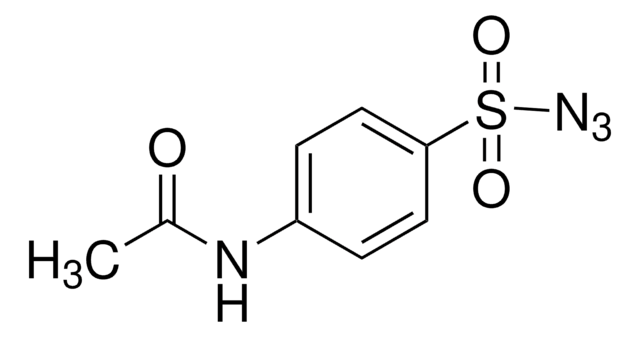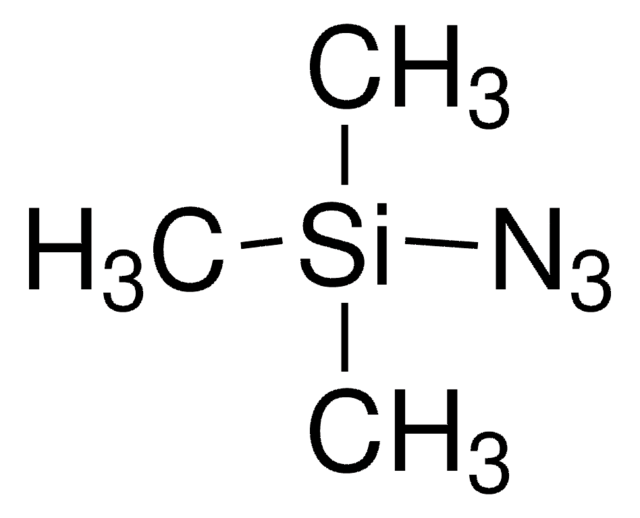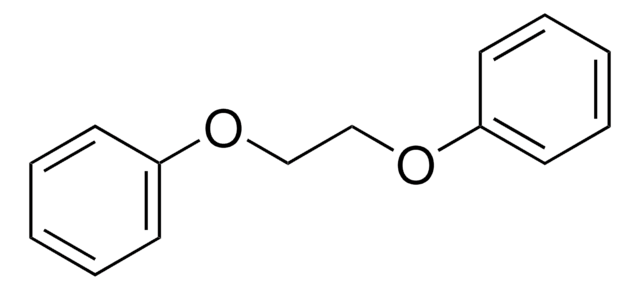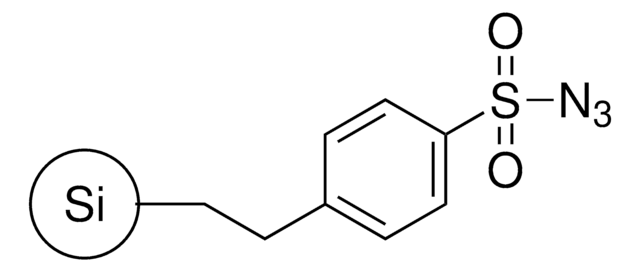178756
Diphenyl phosphoryl azide
97%
Synonyme(s) :
DPPA, Phosphoric acid diphenyl ester azide
About This Item
Produits recommandés
Niveau de qualité
Essai
97%
Forme
liquid
Capacité de réaction
reaction type: click chemistry
Indice de réfraction
n20/D 1.551 (lit.)
pb
157 °C/0.17 mmHg (lit.)
Densité
1.277 g/mL at 25 °C (lit.)
Groupe fonctionnel
azide
Température de stockage
2-8°C
Chaîne SMILES
[N-]=[N+]=NP(=O)(Oc1ccccc1)Oc2ccccc2
InChI
1S/C12H10N3O3P/c13-14-15-19(16,17-11-7-3-1-4-8-11)18-12-9-5-2-6-10-12/h1-10H
Clé InChI
SORGEQQSQGNZFI-UHFFFAOYSA-N
Vous recherchez des produits similaires ? Visite Guide de comparaison des produits
Catégories apparentées
Application
Reagent for synthesis of oligosaccharides linked with carbamate and urea bonds utilizing modified Curtis rearrangement
Mention d'avertissement
Danger
Mentions de danger
Classification des risques
Acute Tox. 3 Dermal - Acute Tox. 3 Inhalation - Acute Tox. 3 Oral - Eye Irrit. 2 - Skin Irrit. 2 - STOT SE 3
Organes cibles
Respiratory system
Code de la classe de stockage
6.1A - Combustible acute toxic Cat. 1 and 2 / very toxic hazardous materials
Classe de danger pour l'eau (WGK)
WGK 3
Point d'éclair (°F)
233.6 °F - closed cup
Point d'éclair (°C)
112 °C - closed cup
Équipement de protection individuelle
Eyeshields, Faceshields, Gloves, type ABEK (EN14387) respirator filter
Faites votre choix parmi les versions les plus récentes :
Déjà en possession de ce produit ?
Retrouvez la documentation relative aux produits que vous avez récemment achetés dans la Bibliothèque de documents.
Les clients ont également consulté
Articles
Fluoroamidinium salts were an advance in acid halogenation. Compared to chlorides, acid fluorides have greater water stability and a lack of conversion to the corresponding oxazolones upon treatment with organic bases.
The chemistry of organoazides is exceedingly rich, since the azide functionality reacts with electrophiles, nucleophiles, and dipolarophiles, with or without the extrusion of dinitrogen. Common place transformation such as Staudinger reductions or ligations, Cu(I)-catalyzed Huisgen cycloadditions (of the “click” reaction family), Curtius or Schmidt rearrangents, nitrene reactions, or imine formation via aza-Wittig reactions all necessitate organoazide precursors or intermediates
Since the preparation of the first organic azide, phenyl azide, by Peter Griess in 1864 this energy-rich and versatile class of compounds has enjoyed considerable interest.
Global Trade Item Number
| Référence | GTIN |
|---|---|
| 178756-1KG | |
| 178756-25G | 4061838753939 |
| 178756-5G | 4061838753946 |
| 178756-100G | 4061838753922 |
| 178756-25KG | |
| 178756-500G | 4061838134875 |
| 178756-5KG | 4061838125224 |
Notre équipe de scientifiques dispose d'une expérience dans tous les secteurs de la recherche, notamment en sciences de la vie, science des matériaux, synthèse chimique, chromatographie, analyse et dans de nombreux autres domaines..
Contacter notre Service technique
![1,8-Diazabicyclo[5.4.0]undéc-7-ène 98%](/deepweb/assets/sigmaaldrich/product/structures/120/564/5b373e23-1624-489c-8efb-692de0f96ffb/640/5b373e23-1624-489c-8efb-692de0f96ffb.png)



![1,4-Diazabicyclo[2.2.2]octane ReagentPlus®, ≥99%](/deepweb/assets/sigmaaldrich/product/structures/366/129/a6ff4175-974d-4fac-9038-b35e508ef252/640/a6ff4175-974d-4fac-9038-b35e508ef252.png)






